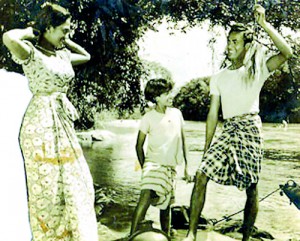Never a dull moment discussing ‘Rekawa’
View(s):It was a journey down memory lane. Those who gathered at the 22nd floor of HNB Towers recently went back six decades (58 years to be exact) – some recalling the days they saw ‘Rekawa’ – Lester James Peries’ first feature film – and the others enjoying a glimpse of what the film looked like and also hearing what people thought about it. Professor Asoka de Zoysa was making a presentation on ‘Rekawa – waking the slumbering Sinhala Cinema’ organised by the National Trust of Sri Lanka.
So much had been talked about and written about ‘Rekawa’ but each time we listen or read about the film, it turns out to be a new experience.
‘Rekawa’– the Line of Destiny’ – as we know, came at a momentous time with the Bandaranaike government coming to power along with a resurgence of the arts. Sinhala was fast replacing English, the national dress was taking precedence over western dress, Sarachchandra had turned a new leaf in Sinhala theatre with ‘Maname’ reviving the traditional nadagam style and LJP had quit the Government Film Unit and was shooting his first feature film.
At the outset, Professor de Zoysa remarked that ‘Rekawa’ “disturbed the audience that was anticipating being entertained with at least 10 songs and dances, much melodrama and slapstick comedy in the time limit of 2 ½ hrs to 3 hrs.” He quoted Rukmani Devi commenting that “it is a pity that a film that takes about three months to shoot, is shown in the short period of three hours. Instead it should be shown a full night lasting five-six hours.
Identifying the main features of ‘Rekawa’, Prof. De Zoysa said it was a feature film shot on location (outside) and not in studios; LJP used two children (Myrtle Fernando as Anula and Somapala Dharmapriya as Sena) who had no experience in acting as main characters; many other actors had no experience in acting;; many extras were people from where the film was shot (at Wewala in Gampaha district); natural sounds were used for background). (It was sad to be reminded that the ten-year-old Myrtle died the following year.
Fr. Marcelline Jayakody with no experience in film songs was commissioned to write the lyrics and Sunil Shantha who, it was said, hated the Sinhala movie songs at of the time, was invited to write the melodies.
The screening of clips from the film with appropriate comments added colour to the presentation. So too the comments by LJP in a chat with Prof de Zoysa. When he asked LJP how the children (in the scene when they accompanied the stilt-walker (Sesha Palihakkara) acted so naturally, he replied that they were asked to watch what was happening. “So they did not – what I would call ‘become performing monkeys in front of the camera as in the reality shows today’. The children from the village genuinely watched and enjoyed the performance of the monkey. To put it bluntly, they were not acting for the camera.
He described the scene with Nimal (Ananda Weerakoon) coming down the river in his ‘oruwa’ thus: “Each frame is an image of great picture quality revealing the picturesque river landscape of Sri Lanka. To me this scene is a role model for many many films to come.”
Prof. De Zoysa summed up the critiques. The film was too long. It had too many songs, although it had just six – all original compositions of Sunil Shantha which became instant hits. It had a love story between the boatman and Sena’s sister (Mallika Pilapitiya) which was not woven into the main plot. (“May be this was to appease the audience of that time”).
It was also said that Siriyala was not a Sinhala village. There were no Buddhist monks at the funeral and no temple. Sinhala villagers are not so wicked as to throw stones at a small boy. Cunning village people should not be shown – it gives a bad impression on Ceylon. There was too much exotic pageantry and folklore – a wedding, a funeral, puppet shows, rituals etc.
What was his own opinion of ‘Rekawa’? “In some ways it was showing the path to move forward. It brought new ideas, how a movie can be made, based on excellent training and world standard equipment. ‘Rekawa’ showed an in-depth research on the subject. And above all, LJPs direction in enhancing talent in acting, art direction, editing, script, dialogue and song writing and cinematography . LJP was able to balance the energies of the young people keen to show new ways of making a Sinhala movie.”
He also pointed out that LJP did not stick to the Sinhala village he loved but located Delovakathara and Ransalu in Colombo. Titus Thotawatta went forward, Willie Blake too and Iranganie Serasinhagave us many memorable scenes.
“In the next years, joining hands with Sumitra Gunawardana, Dr. Lester James Peries has endowed Sri Lanka’s heritage with many world class films.A very humble and hospitable man, down Dickmans Road (today named after him) is behind the new Sinhala Cinema that was born in 1956.”
He concluded: “As such ‘Rekawa’ stands as a milepost, or a sign board pointing to another direction. Maybe it was a silver line – a’rekawa’ on a dark cloud of commercial Sinhala cinema producing films just to entertain.
He acknowledged the gesture by the Torana chief in allowing him to use the clippings from the DVD. Having seen the film in December 1956 and once or twice later, I still bought the DVD the next day inspired by what Prof. De Zoysa showed and said.



